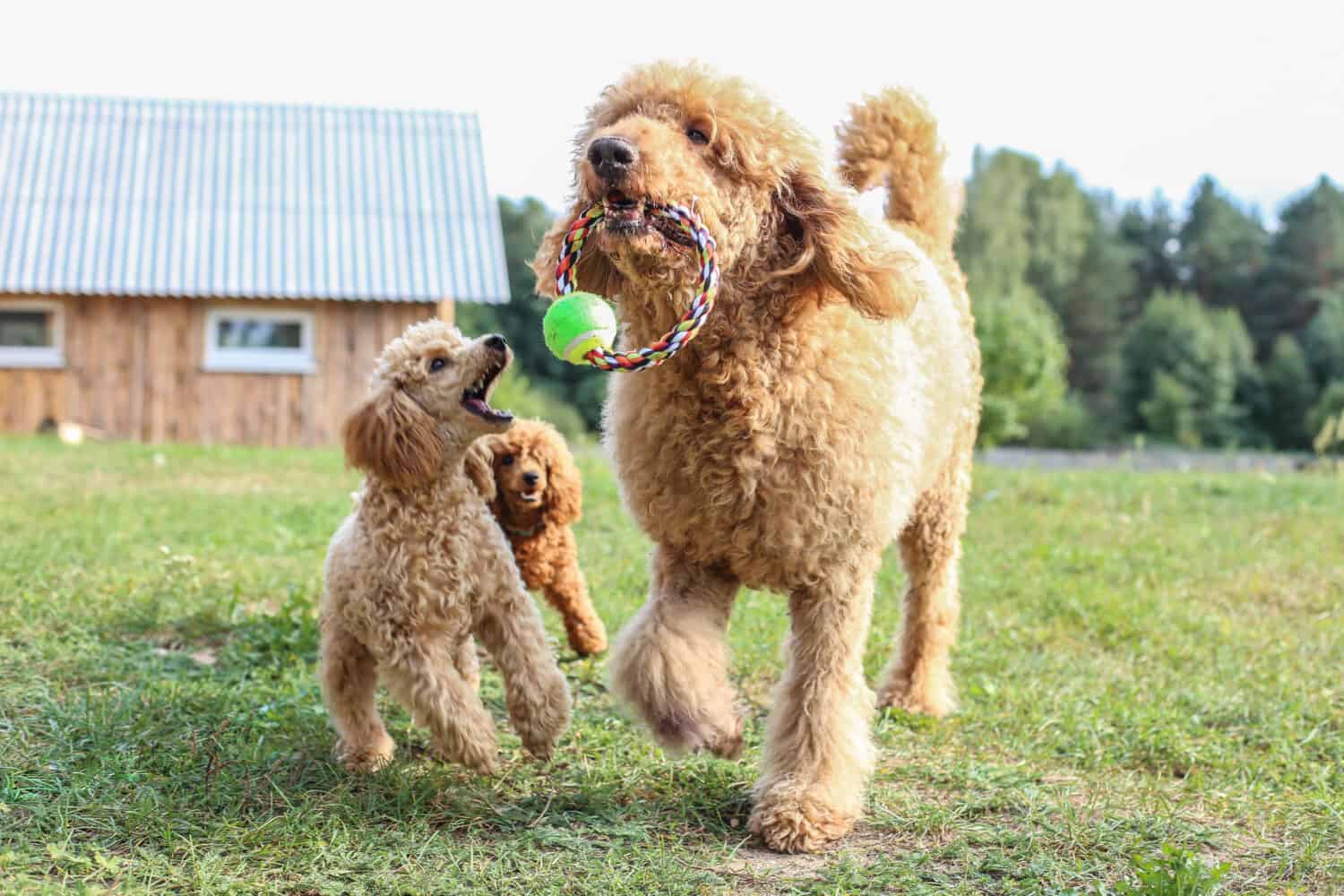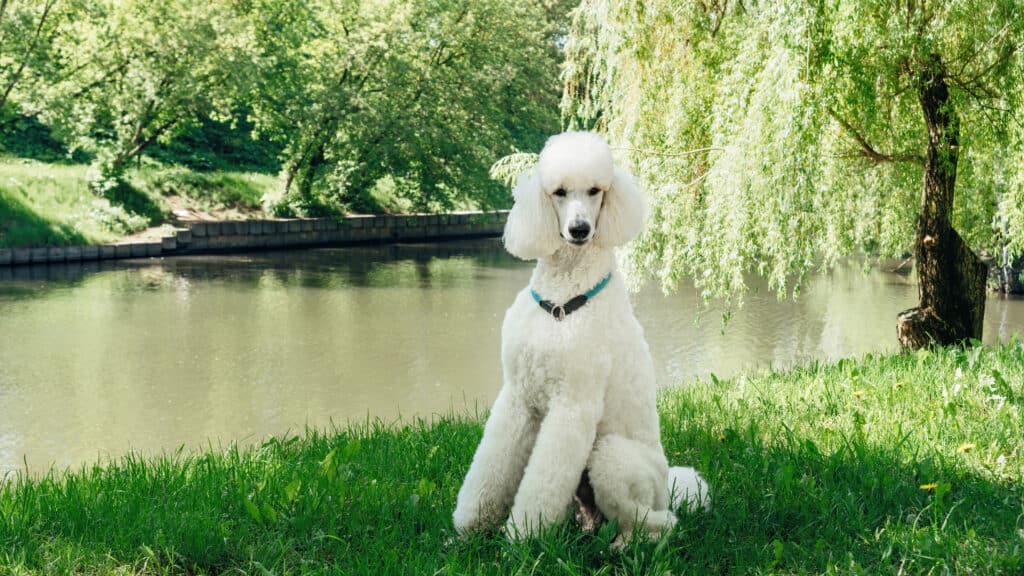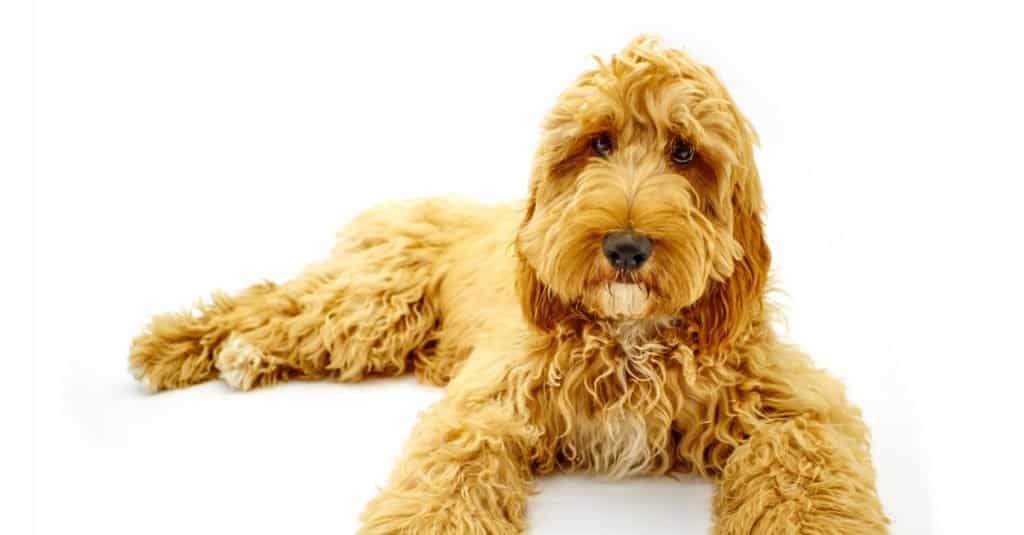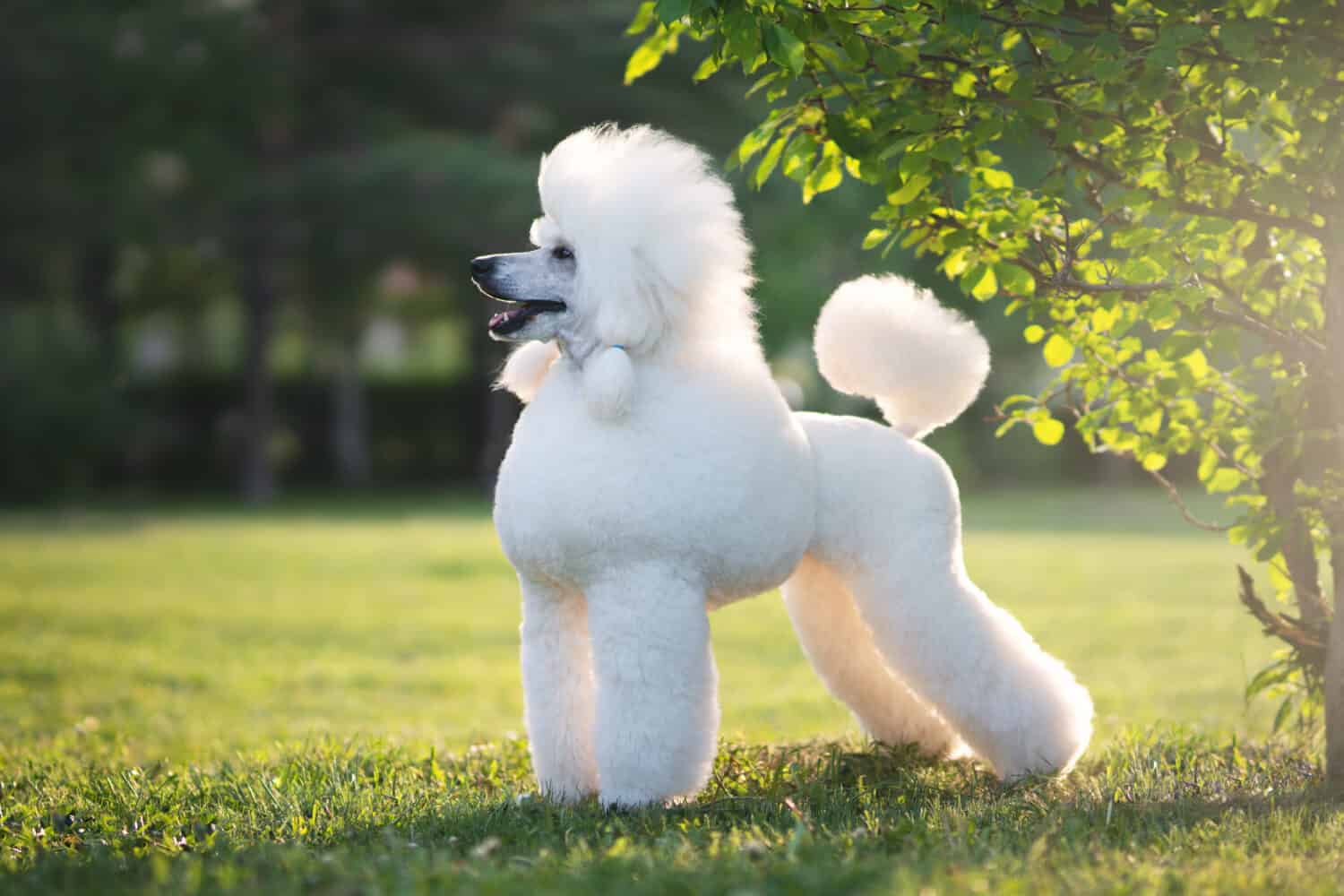
Toy, miniature, and standard are labels for small, medium, and large poodles.
©Velimir Zeland/Shutterstock.com
If you’re wondering what the differences are between a royal and a standard poodle, the short answer is: there are none. At least not officially. Put another way, royal poodles don’t actually exist.
Confused? Let me explain…
Technically, poodles – renowned for their elegance and intelligence – only come in three types, according to the American Kennel Club (AKC): standard, miniature, and toy. Clearly based on size, these descriptors are pretty much the canine equivalents of Starbuck’s venti, grande, and tall offerings. As ventis, standard poodles are the largest. They measure at least 15 inches (38 cm) or more at the highest point of their shoulder and weigh between 45 to 70 pounds (20 to 32 kg) when fully grown. Miniature poodles – or grandes- are typically 12 to 20 pounds (5.4 to 9.1 kg) and stand 10 to 15 inches. And toy poodles – the talls – weigh in at a mere 4 to 6 pounds (1.8 to 2.7 kg) and measure just under 10 inches.
The ridiculousness of comparing poodles to lattes aside, standard, miniature, and toy are considered both sizes and types due to the distinct characteristics associated with each one. While all poodles are next-level smart – ranked by canine neuropsychologist Stanley Coren as the second most intelligent breed of dogs – they do have some disparities among them. Of course, they share many key characteristics, but their size differences can also contribute to nuanced variations in temperament, energy levels, and adaptability.
Standards, for instance, exude grace and versatility – often excelling in sports and agility. As big, energetic dogs, they need a bit more room to run around and tend to do best if they have somewhere to romp and play. Miniatures exhibit equally charming personalities, but because they are smaller, acclimate more easily to both city and suburban living. Meanwhile, toys are a popular choice for urban households. They, too, are just as bright and sprightly as their larger colleagues, but do not require the same amount of space. Their compact frames often make toy poodles ideal for apartment living.
So, then, what the heck is a royal poodle? And why aren’t they on this list?
Royal Poodles are Just Extra Tall Standard Poodles

“Royal” poodles are really just extra tall standard poodles, so this term is not recognized by the American Kennel Club.
©nieriss/Shutterstock.com
As it turns out, the term royal poodle does not refer to a separate or distinct poodle breed at all. Instead, it is an informal label some breeders use to promote the tallest variants of their dogs. For these reasons, using this phrase is somewhat controversial. Some organizations, for instance, have called out this designation as a marketing gimmick or ploy. Because it is really nothing more than a fancy way of referring to an extra tall standard poodle.
But why?
As we discussed above, on average, standard poodles stand 15 inches or more at the highest point of the shoulders. As the tallest of these, “royals” tower up to 25 inches (63.5 cm) or higher at the shoulder and generally weigh over 60 pounds (27.22 kg) when fully matured. If we return to our Starbucks metaphor for a second, in an alternate universe, they might be considered trentas. But this comparison is imperfect and ultimately falls apart. That’s because, according to the AKC – who sets breed standards for purebred dogs in the first place – there is no such thing as a fourth size with poodles. Experts agree: extra tall poodles are not their own separate type, no matter what individual breeders may attest. Using that term would roughly be semantically commensurate with labeling someone who is 6’7″ a royal human. Pretty funny to imagine, right?
In essence, even though it is a super cute name, royal poodles aren’t really a thing.
Oodles of Poodles

Poodle mixes are designer dogs who have become increasingly popular – with several pros and cons worth considering.
©Kitch Bain/Shutterstock.com
Maltipoos. Sheepadoodles. Havapoos. Bernedoodles. Schnoodles. Doodles. Yorkie Poos. Corgipoos. Doxiepoos. Poogles. Cockapoos. Bordoodles. Peekapoos. While the AKC may only recognize three types of poodles, humans still love poodle mixes. Despite the many adorable names on this list, there still are several more varieties. As descriptors, these names linguistically blend poodle with the second type of breed present in the mix. A doxiepoo, for example, is clearly a cross between a dachshund and a miniature poodle. Marketed as hypoallergenic and healthier than purebred poodles, such mixes are increasingly popular. Understandably, people love the looks and personalities of these hybrid dogs and hope to find the very best qualities of two of their favorite types of dogs in one complete package. But this is not necessarily a good thing.
As designer dogs, oodles of poodles have been strategically created by breeders. The idea is to make puppies who inherit the best traits and characteristics of both parents. Mixing breeds is ultimately healthier for the dogs, many breeders claim, since mating two separate breeds results in hybrid vigor. Also known as heterosis, hybrid vigor is a natural phenomenon wherein the offspring of two diverse breeds or strains of organisms display superior characteristics when compared to their parents. However, there is not much evidence to support the theory of hybrid vigor. Without proper genetic testing, it is just as possible that crossbreeding will result in dogs who inherit the worst traits – including undesirable temperaments and/or genetic issues – of both parents.
Not to mention the misleading marketing claims that poodle mixes are hypoallergenic. Although we have all heard that poodles don’t cause allergies, there is little scientific evidence to support such statements. In reality, no dog breed is 100 percent hypoallergenic, even though some may be slightly less likely to cause allergic reactions. But research investigating allergens from dogs in household environments has proven that there was no real distinction in allergen levels between conventional dogs and those labeled as ‘hypoallergenic’. If this information seems shocking or surprising, you can see just how effective these advertising campaigns have been. The notion of a hypoallergenic dog is somewhat deceptive and can cause people to buy and then surrender these dogs when they don’t meet medical expectations.
Perhaps worst of all, the high demand for poodle mixes – fueled by false sales pitches – has led to skyrocketing prices. In turn, the high cost of poodle mixes only encourages puppy mills and backyard breeders to produce more dogs en masse with little concern for their care. Dog breeding in general is an ethical quandary. Not only are countless dogs mistreated and abused in puppy mills and by irresponsible breeders, but humans are creating a surplus of companion animals – an act that all too often leads to their untimely deaths.
Part of this is fashion, of course. Dog trends come and go and the desire for designer dogs continuously evolves. People’s preferences change along with the fads of the day. Naturally, breeders respond. But it creates a vicious cycle.
On the one hand, humans pay premium prices for specific mixed breeds to other humans who then often make exorbitant profits. On the other hand, shelters and rescues are overflowing with perfectly healthy, beautiful dogs, many of whom are also mixed breeds. A lot of these dogs will not make it out alive. Instead, they are euthanized for space. With systemic overcrowding, mixed breeds and even purebred dogs are dying by the thousands every day across the US. The harrowing irony here is that many of these deserving dogs are poodles and poodle mixes.
It is very easy to understand the urge to buy your dream dog. But you could also find the canine love of your life at an adoption event while saving their life simultaneously.
All Poodles are Royal
No matter where you met and fell in love with your poodle, you adore them like crazy. And for poodle aficionados, all three types are likely regal and worthy of praise. So how do you treat your poodle like royalty? Whether you have a toy, miniature, or standard size, most poodles have similar needs. Mental and physical stimulation, daily exercise, proper nutrition, consistent grooming routines, regular visits to the veterinarian, and plenty of affection will help them live long, healthy lives.
As I mentioned above, poodles are incredibly clever, social, and curious. Like most dogs, they need to frolic and play every day to stave off boredom and help maintain their overall well-being. Additionally, poodles thrive on social interaction. Consistent quality time with their humans, socialization with other dogs, and exposure to various environments will support their emotional health. Grooming is also important for maintaining their distinctive coats, and a high-quality diet and regular veterinary care will buttress their physical health. Positive reinforcement training and enrichment are also vital for strengthening your bond, stimulating their active minds, and boosting their happiness.
When it comes to treating and entertaining your poodles like the queens, kings, princesses, and princes they are, a little creativity goes a long way. Since all poodles are majestic, perhaps royal poodles are real after all.
Ready to discover the top 10 cutest dog breeds in the entire world?
How about the fastest dogs, the largest dogs and those that are -- quite frankly -- just the kindest dogs on the planet? Each day, AZ Animals sends out lists just like this to our thousands of email subscribers. And the best part? It's FREE. Join today by entering your email below.
Thank you for reading! Have some feedback for us? Contact the AZ Animals editorial team.








